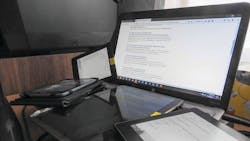Today’s e-Readers are an amazing piece of digital technology. They are lightweight, have long-lasting batteries, and have a huge amount of storage. For someone like me who loves to read and needs specifications, standards and contracts in the field, they have proven to be a magical tool. In today’s crazy COVID-19 world, we need all the magic available. I use one device for project related documents — standards, guidelines, and user manuals. Another device has books, magazines and newspapers.
Don’t get me wrong, I still have a laptop and tablet, but my e-Readers make my life simpler, unless you’re talking about airport security. There is something about having lots of digital devices that seems to really upset the screeners. All in all, however, these small devices have more pros than cons. The biggest advantage for me is having a virtual library at my fingertips, and they are super user-friendly.
Being user-friendly is important as our world gets more complicated. Recently, I ran into a book that I’d like to share. It puts user-friendly into a different perspective as life gets more complex. Actually, it was the title that caught my attention: User Friendly: How the Hidden Rules of Design Are Changing the Way We Live, Work, and Play, by Cliff Kuang and Robert Fabricant. That title intrigued me, and I wanted more information, so I pulled it up on my e-Reader’s shopping feature.
I was hooked by the sample of the first chapter with its narrative of the 1979 Three Mile Island nuclear calamity, so I bought it. Heck, I’m a utility engineer and that has been a fascinating story for a lot of us. The authors did a great deal of research and presented the story from a different perspective than I had previously seen.
User-Friendly
Since this isn’t a book review, I won’t spoil the book for the anyone interested in reading it. In a nutshell, the Three Mile Island nuclear power plant catastrophe started with a mechanical malfunction. The plant’s self-protection features started working, but the operators couldn’t follow the data displayed by the control room panels. They intervened and the rest is history. As a result of this mishap, a lot of user-friendliness theories changed for the better.
The book has many other fascinating stores about technologies and their human interfaces. It points out that this interface has to be uncomplicated, intuitive, and seamless to be effective (i.e., user-friendly) and the Three Mile Island control room wasn’t. As I read, I started thinking about similar technologies I had run into in my career. One of the first to come to mind was the first HVDC (high voltage direct current) converter station I worked on.
It was designed a few years after Three Mile Island, so it represented the same type of user control room interface logic. In other words, it required a lot of experience to be able to operate and understand what was taking place on that control room’s reporting devices. Every morning there would be 50 ft (15.24 m) of event recorder printout littering the floor from the prior evening. It could take an hour to check out the printout before knowing if something important happened.
Some 20-plus years later, the utility decided to upgrade the station’s technology. When the dust settled, a new state-of-the-art, 21st-century control system had been installed. All the archaic 1980s user interface points were replaced by two computer screens and a mouse. When something happened at the station a quick check of the computer screens told what was taking place, where it was, and what systems it affected — no guesswork required.
After the controls upgrade, it was possible for the utility’s remote staff and the manufacturer’s service engineers and technicians to visit the station virtually. Remote personnel could assist the station’s personnel with troubleshooting, technical assistance, and many other functions. When this was installed, no one could have predicted how important this user-friendly packed upgrade would become. It turns out this was one of those serendipitous events that are paying dividends in today’s world.
Arthur C. Clark said it best, “Any sufficiently advanced technology is indistinguishable from magic,” and we can certainly use magic today.
When you consider how digital technologies have been combined with artificial intelligence, augmented reality, and virtual reality we have a self-monitoring grid that is almost self-aware. That would’ve been magic a few years ago!
About the Author
Gene Wolf
Technical Editor
Gene Wolf has been designing and building substations and other high technology facilities for over 32 years. He received his BSEE from Wichita State University. He received his MSEE from New Mexico State University. He is a registered professional engineer in the states of California and New Mexico. He started his career as a substation engineer for Kansas Gas and Electric, retired as the Principal Engineer of Stations for Public Service Company of New Mexico recently, and founded Lone Wolf Engineering, LLC an engineering consulting company.
Gene is widely recognized as a technical leader in the electric power industry. Gene is a fellow of the IEEE. He is the former Chairman of the IEEE PES T&D Committee. He has held the position of the Chairman of the HVDC & FACTS Subcommittee and membership in many T&D working groups. Gene is also active in renewable energy. He sponsored the formation of the “Integration of Renewable Energy into the Transmission & Distribution Grids” subcommittee and the “Intelligent Grid Transmission and Distribution” subcommittee within the Transmission and Distribution committee.
